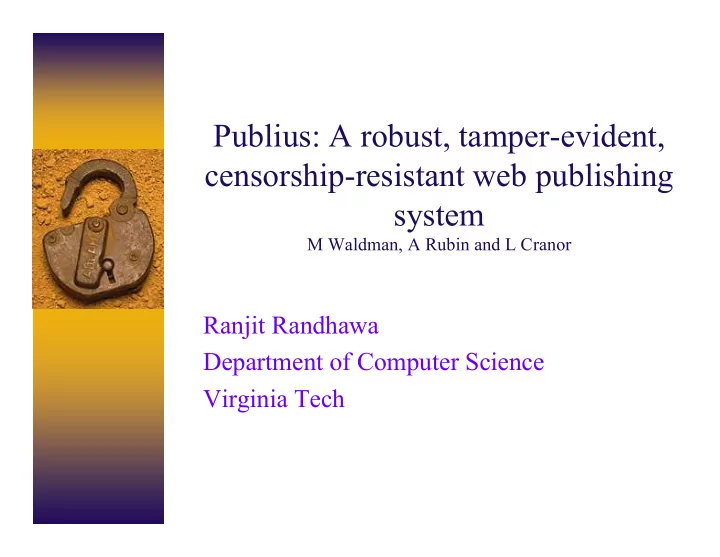

Publius: A robust, tamper-evident, censorship-resistant web publishing system M Waldman, A Rubin and L Cranor Ranjit Randhawa Department of Computer Science Virginia Tech
Outline ♦ Overview of Publius ♦ Anonymity tools ♦ Publius in detail – Publish – Retrieve – Delete – Update – Example ♦ Publishing issues ♦ Limitations
Overview of Publius ♦ Web publishing system ♦ Highly resistant to censorship ♦ Provides publishers with a high degree of anonymity ♦ Social issues – Censorship – DMCA
Overview cont’d ♦ Publius consists of: – Publishers: who post Publius content to the web – Servers: who host random-looking content – Retrievers: who browse Publius content on the web
Anonymity tools I ♦ Connection based anonymity tools – Provide connection based anonymity ♦ Tools – Anonymizer (Proxy server) – Mix models – Onion Routing – Crowds – Freedom Anonymity System
Anonymity tools II ♦ Author based Anonymity tools – Hide location or author of a web document ♦ Tools – Janus/Rewebber • Combination connection/author based tool • Anonymizer + URL rewriting service – Andersons Eternity Service • Server based storage • Once copied, never removed – FreeNet • Adaptive network, stores files locally in nodes (which db) – Intermemory • Focus is on preservation of electronic media
Publius - Publish ♦ Encrypt content M with key K (produces {M} k ) and split K into n shares using Shamir secret sharing – Any k of them can reproduce the secret ♦ Compute 8 byte long name for all n (for addressing) – name i = wrap(H(M.share i )) [ H = cryptographic hash] ♦ Computer location ( m = servers on system) – location i = (name i , MODm) + 1 – Obtain n values between 1 and m iff > d >= k ( d = min number of servers that will hold the Publius content) ♦ Publish Publius {M}k.share i in dir name i , on servers at locations location i (index into list of servers) ♦ URL contains d name i values concatenated together
Publius - Retrieve ♦ From Publius URL, U , parse out name i values ♦ location i = (name i , MODm) + 1 ♦ Index in table of servers for each of the shares ♦ Choose k arbitrarily and retrieve encrypted file – File named file stored on each server in name i directory ♦ Retrieve other k-1 shares ♦ Combine all shares to form key K and decrypt file ♦ Verify all name i values are correct (regenerate U ) – If not, try different set of k shares
Publius - Delete ♦ Before publishing password PW generated ♦ Send encrypted document, share and hash of domain name concatenated with PW to servers that will host the document ♦ To delete send hash of domain name concatenated with PW to each server along with name i that corresponds to that server ♦ Server removes directory matching the name i and all its files.
Publius - Update ♦ Enable publisher to change content without changing the URL ♦ Publisher specifies filename (containing new content), original URL, original PW and new PW . ♦ Update program first publishes new content ♦ Original URL used to fine n servers that host original content. ♦ Each server then places the new URL in the update file and deletes the contents of the old file ♦ When user requests file that has been updated the servers return the update URL instead of the contents
Example Publius URL ♦ Publius URL – http://!anon!/options encode(name 1 )…encode(name n ) ♦ Encode function generates ASCII representation of name i value ♦ Options – 2 characters that define how Publius client software interpret URL (as there are no file extensions) – 16 bit options section encodes • Version number, number of shares needed and update flag
Publishing Issues ♦ Publish files A and B – Where A contains link to B – Where A and B contain links to each other ♦ Publish a directory
Limitations ♦ Share deletion/corruption ♦ Update file deletion/corruption ♦ DoS attacks ♦ Threats to publisher anonymity ♦ Rubber-Hose cryptanalysis
Recommend
More recommend